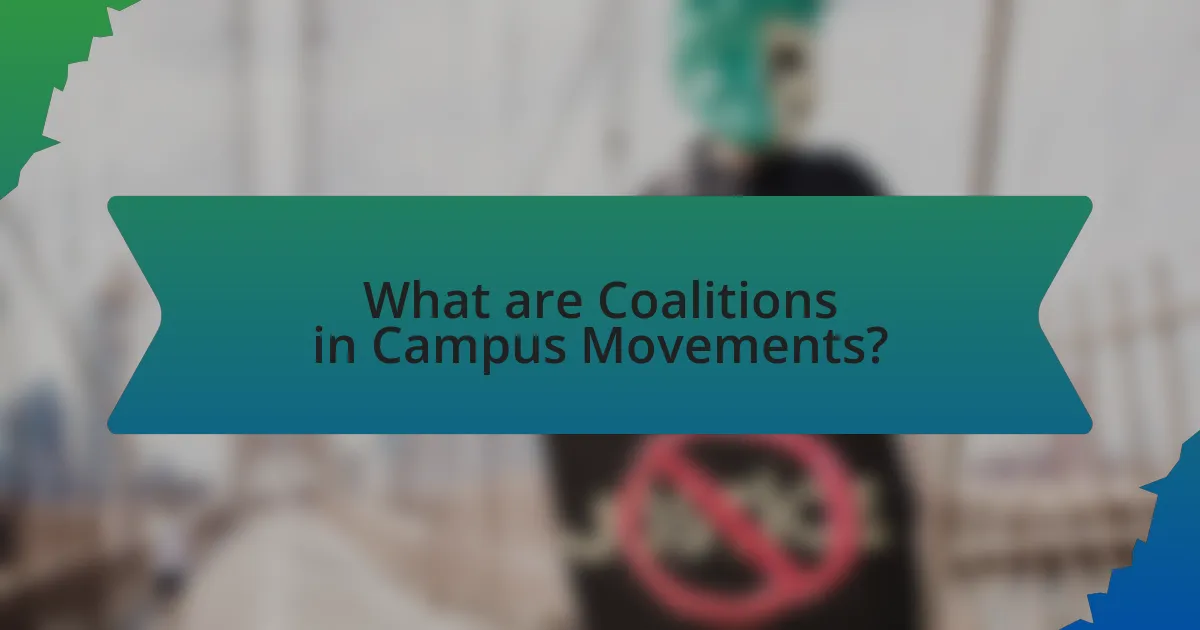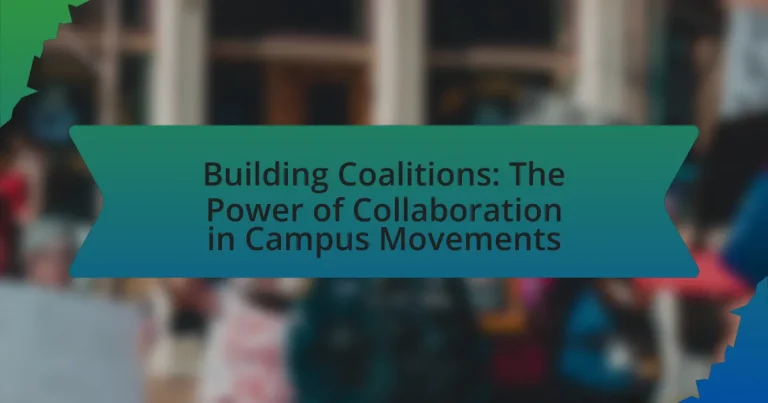The article focuses on the significance of coalitions in campus movements, highlighting how collaborative alliances among student organizations can effectively address social, political, and educational issues. It explores the formation of these coalitions through shared goals and mutual interests, emphasizing the roles of student organizations in fostering collaboration. The article also discusses the advantages of collaboration, such as enhanced resource sharing and increased visibility, while addressing challenges like differing agendas and communication barriers. Additionally, it outlines best practices for building sustainable coalitions, including establishing clear goals, fostering open communication, and engaging diverse stakeholders to maintain momentum and achieve long-term impact.

What are Coalitions in Campus Movements?
Coalitions in campus movements are collaborative alliances formed by various student organizations and groups to achieve common goals related to social, political, or educational issues. These coalitions leverage the diverse strengths and resources of their members to amplify their collective voice and impact, often addressing systemic injustices or advocating for policy changes within the institution. For instance, coalitions may unite groups focused on racial equality, environmental sustainability, and gender rights to create a more powerful and unified front, enhancing their effectiveness in mobilizing support and resources.
How do coalitions form within campus movements?
Coalitions within campus movements form through shared goals, mutual interests, and collaborative efforts among diverse student groups. These coalitions often emerge when different organizations recognize overlapping objectives, such as advocating for social justice, environmental sustainability, or educational reform. For instance, the formation of coalitions can be seen in movements like the March for Our Lives, where student groups united to address gun violence, demonstrating the effectiveness of collective action. Research indicates that successful coalitions leverage the strengths of various organizations, fostering a sense of solidarity and enhancing their impact on campus policies and culture.
What roles do student organizations play in coalition building?
Student organizations play a crucial role in coalition building by fostering collaboration among diverse groups to address common goals. They serve as platforms for communication, enabling different organizations to share resources, strategies, and support. For instance, student organizations often organize joint events or campaigns that unite various student bodies, enhancing visibility and impact. Research indicates that coalitions formed through student organizations can lead to more effective advocacy efforts, as seen in movements like the 2017 March for Science, where multiple organizations collaborated to amplify their message on climate change. This collaborative approach not only strengthens individual organizations but also creates a unified front that can influence campus policies and broader societal issues.
How do shared goals influence coalition formation?
Shared goals significantly influence coalition formation by aligning the interests and motivations of diverse groups, facilitating collaboration. When organizations or individuals identify common objectives, they are more likely to unite their resources and efforts, creating a stronger collective impact. Research indicates that coalitions formed around shared goals can enhance communication, increase trust among members, and improve overall effectiveness in achieving desired outcomes. For instance, studies in social movements demonstrate that groups with clearly defined, mutual goals are more successful in mobilizing support and resources, as seen in various campus movements advocating for social justice and policy changes.
Why is collaboration important in campus movements?
Collaboration is important in campus movements because it amplifies voices, unites diverse perspectives, and enhances resource sharing. When students collaborate, they can combine their strengths, leading to more effective advocacy and greater impact on policy changes. Research indicates that movements with collaborative efforts are more likely to achieve their goals; for instance, the 2018 March for Our Lives, which united various student organizations, successfully influenced gun control discussions in the U.S. This demonstrates that collaboration not only fosters solidarity but also increases the likelihood of tangible outcomes in campus movements.
What advantages does collaboration provide to campus activists?
Collaboration provides campus activists with enhanced resource sharing, increased visibility, and a stronger collective voice. By working together, activists can pool financial resources, access diverse skill sets, and share networks, which amplifies their impact. For instance, a study by the National Campus Leadership Council found that coalitions can lead to a 30% increase in event attendance and engagement, demonstrating the effectiveness of unified efforts in mobilizing support for causes.
How does collaboration enhance the effectiveness of campus movements?
Collaboration enhances the effectiveness of campus movements by pooling diverse resources, skills, and perspectives, which leads to more comprehensive strategies and greater impact. When various student organizations and individuals unite, they can mobilize larger groups, share knowledge, and amplify their voices, resulting in increased visibility and influence. For instance, a study by the American Council on Education found that collaborative efforts among student groups can lead to a 30% increase in participation rates for events and initiatives. This collective action not only strengthens the movement’s message but also fosters a sense of community and shared purpose among participants, ultimately driving more significant change on campus.
What challenges do coalitions face in campus movements?
Coalitions in campus movements face challenges such as differing priorities among member groups, resource allocation conflicts, and communication barriers. These challenges arise because diverse organizations often have unique goals and agendas, which can lead to disagreements on strategies and objectives. For instance, a coalition may struggle to unify its members around a common cause if some prioritize social justice while others focus on environmental issues. Additionally, limited funding and resources can create competition among coalition members, hindering collaboration. Effective communication is also crucial; misunderstandings can arise from varying communication styles or lack of transparency, further complicating coalition dynamics. These factors collectively impede the effectiveness and cohesion of coalitions in campus movements.
How do differing agendas impact coalition dynamics?
Differing agendas significantly impact coalition dynamics by creating tensions and challenges in collaboration. When coalition members prioritize distinct goals, it can lead to conflicts over resource allocation, strategic direction, and decision-making processes. For instance, a study by the National Democratic Institute highlights that coalitions with aligned agendas are more effective in achieving their objectives, while those with divergent priorities often struggle to maintain unity and focus. This fragmentation can result in weakened collective action and diminished overall effectiveness in campus movements.
What strategies can coalitions use to overcome conflicts?
Coalitions can use negotiation, mediation, and open communication as strategies to overcome conflicts. Negotiation allows coalition members to discuss their differences and reach mutually acceptable solutions, while mediation involves a neutral third party facilitating discussions to help resolve disputes. Open communication fosters transparency and trust among members, enabling them to express concerns and collaborate effectively. Research indicates that coalitions that prioritize these strategies are more successful in maintaining unity and achieving their goals, as evidenced by case studies in various campus movements where conflicts were resolved through structured dialogue and collaborative problem-solving.

How do Successful Coalitions Operate?
Successful coalitions operate through clear communication, shared goals, and mutual respect among diverse stakeholders. These elements foster collaboration, enabling coalition members to align their efforts effectively. Research indicates that coalitions with defined objectives and open dialogue are more likely to achieve their aims, as evidenced by the success of various campus movements that have utilized these principles to mobilize support and resources. For instance, the United Students Against Sweatshops coalition effectively united students across multiple campuses by establishing common goals and maintaining transparent communication, leading to significant advocacy successes.
What are the key characteristics of effective coalitions?
Effective coalitions are characterized by shared goals, strong leadership, diverse membership, clear communication, and mutual trust. Shared goals ensure that all members are aligned in their objectives, which enhances collaboration and commitment. Strong leadership provides direction and motivates members to engage actively in coalition activities. Diverse membership brings various perspectives and resources, enriching the coalition’s capacity to address complex issues. Clear communication fosters transparency and facilitates coordination among members, while mutual trust builds a supportive environment that encourages collaboration and resilience. These characteristics are essential for the success and sustainability of coalitions, particularly in dynamic contexts like campus movements.
How does communication shape coalition success?
Communication is essential for coalition success as it facilitates understanding, coordination, and trust among members. Effective communication ensures that all participants are aligned with the coalition’s goals, strategies, and actions, which is critical for mobilizing resources and support. Research indicates that coalitions with strong communication networks are more likely to achieve their objectives, as evidenced by a study published in the “American Journal of Community Psychology,” which found that coalitions with regular communication meetings reported higher levels of member engagement and successful outcomes. This demonstrates that clear, consistent communication directly influences the effectiveness and sustainability of coalitions in campus movements.
What role does leadership play in coalition effectiveness?
Leadership is crucial for coalition effectiveness as it provides direction, fosters collaboration, and enhances communication among diverse groups. Effective leaders establish a shared vision, align goals, and motivate members, which is essential for maintaining unity and purpose within the coalition. Research indicates that coalitions with strong leadership are more likely to achieve their objectives, as leaders facilitate conflict resolution and encourage participation, leading to increased commitment and resource sharing among members. For instance, a study by the National Network of Partnership Schools found that effective leadership in educational coalitions significantly improved student outcomes by promoting collaborative strategies and stakeholder engagement.
How do coalitions mobilize resources and support?
Coalitions mobilize resources and support by leveraging collective strengths, establishing networks, and engaging in strategic communication. By uniting diverse organizations and individuals, coalitions can pool financial resources, share expertise, and access broader networks, which enhances their capacity to advocate for common goals. For instance, the United States Student Association has effectively mobilized student groups across campuses to advocate for educational reforms, demonstrating how collaborative efforts can amplify voices and attract funding from external sources. This collaborative approach not only increases visibility but also fosters a sense of shared purpose, which is critical for sustaining momentum and garnering ongoing support.
What types of resources are essential for coalition success?
Essential resources for coalition success include human resources, financial resources, informational resources, and material resources. Human resources, such as committed individuals and skilled leaders, are crucial for mobilizing efforts and fostering collaboration. Financial resources provide the necessary funding for activities, outreach, and events, enabling coalitions to operate effectively. Informational resources, including data and research, support informed decision-making and strategy development. Material resources, such as meeting spaces and technology, facilitate communication and coordination among coalition members. These resources collectively enhance the coalition’s capacity to achieve its goals and sustain its efforts over time.
How can coalitions leverage community support?
Coalitions can leverage community support by actively engaging local stakeholders and fostering partnerships that align with shared goals. By organizing community events, coalitions can raise awareness and build trust, which encourages participation and investment from community members. Research indicates that initiatives involving community input and collaboration lead to higher success rates; for instance, a study by the Community Tool Box found that community engagement increases project sustainability and effectiveness. Therefore, coalitions that prioritize community involvement not only enhance their support base but also improve the overall impact of their initiatives.
What impact do coalitions have on campus culture?
Coalitions significantly enhance campus culture by fostering inclusivity and collaboration among diverse student groups. These alliances create a unified voice that advocates for social justice, equity, and representation, leading to a more engaged and supportive campus environment. Research indicates that campuses with active coalitions experience increased student participation in cultural events and initiatives, which promotes a sense of belonging and community. For instance, a study by the American Council on Education found that institutions with strong coalition-building efforts reported higher levels of student satisfaction and retention, demonstrating the positive impact of these collaborations on overall campus culture.
How do coalitions influence student engagement and activism?
Coalitions significantly enhance student engagement and activism by uniting diverse groups around common goals, thereby amplifying their collective voice. This collaboration fosters a sense of community and shared purpose, which motivates students to participate actively in initiatives. For instance, research by the National Student Leadership Development Conference indicates that students involved in coalitions report higher levels of engagement and satisfaction in their activism efforts compared to those acting independently. By pooling resources, knowledge, and networks, coalitions create a more impactful platform for advocacy, leading to increased visibility and effectiveness of student-led movements.
What long-term changes can result from successful coalitions?
Successful coalitions can lead to significant long-term changes such as enhanced policy influence, increased resource allocation, and strengthened community engagement. These coalitions often result in the establishment of sustainable networks that advocate for shared goals, thereby amplifying their collective voice in decision-making processes. For instance, research indicates that coalitions formed during campus movements have historically led to policy reforms, such as the implementation of more inclusive practices and increased funding for marginalized student groups. This demonstrates that successful coalitions not only achieve immediate objectives but also create lasting impacts on institutional policies and community dynamics.

What are Best Practices for Building Coalitions?
Best practices for building coalitions include establishing clear goals, fostering open communication, and ensuring diverse representation. Clear goals align coalition members towards a common purpose, enhancing focus and effectiveness. Open communication builds trust and facilitates collaboration, allowing for the sharing of ideas and resources. Diverse representation ensures that various perspectives are included, which strengthens the coalition’s impact and reach. Research indicates that coalitions with diverse members are more successful in achieving their objectives, as they can address a wider range of issues and engage more stakeholders effectively.
How can campus activists effectively initiate coalition-building?
Campus activists can effectively initiate coalition-building by identifying shared goals and values among diverse groups. This approach fosters collaboration by creating a common purpose that resonates with various stakeholders. For instance, research indicates that successful coalitions often begin with inclusive dialogues that allow different organizations to express their priorities and concerns, leading to a unified agenda. Additionally, establishing clear communication channels and regular meetings enhances trust and cooperation, which are essential for sustaining coalition efforts.
What steps should be taken to identify potential coalition partners?
To identify potential coalition partners, organizations should first conduct a stakeholder analysis to identify groups with shared interests and goals. This involves mapping out existing organizations, their missions, and their influence within the campus community. Next, organizations should engage in outreach efforts, such as hosting informational meetings or forums, to gauge interest and establish connections with potential partners. Additionally, assessing the values and objectives of these groups ensures alignment and compatibility for collaboration. Research indicates that successful coalitions often emerge from shared objectives, as seen in various campus movements where diverse organizations unite for common causes, enhancing their collective impact.
How can activists establish trust among coalition members?
Activists can establish trust among coalition members by fostering open communication and transparency in decision-making processes. This approach encourages members to share their perspectives and concerns, which builds a sense of belonging and mutual respect. Research indicates that coalitions with clear communication channels and shared goals are more effective; for instance, a study by the National Network for Collaboration found that trust is significantly enhanced when coalition members engage in regular, honest dialogue and collaborative problem-solving. By prioritizing these practices, activists can create a solid foundation of trust that strengthens their coalition’s effectiveness.
What strategies can enhance coalition sustainability?
Strategies that can enhance coalition sustainability include establishing clear goals, fostering open communication, and ensuring diverse stakeholder engagement. Clear goals provide a shared vision that aligns the coalition’s efforts, while open communication facilitates trust and collaboration among members. Engaging diverse stakeholders ensures that various perspectives are included, which can strengthen the coalition’s foundation and adaptability. Research indicates that coalitions with defined objectives and inclusive practices are more likely to endure and achieve long-term impact, as evidenced by studies showing that successful coalitions often maintain higher levels of member satisfaction and commitment over time.
How can coalitions maintain momentum over time?
Coalitions can maintain momentum over time by establishing clear goals, fostering strong communication, and engaging members consistently. Clear goals provide direction and purpose, ensuring that all coalition members are aligned and motivated towards a common objective. Strong communication facilitates transparency and collaboration, allowing members to share updates, celebrate successes, and address challenges collectively. Engaging members through regular meetings, events, and outreach activities keeps the coalition dynamic and encourages active participation. Research indicates that coalitions with structured communication and engagement strategies are more likely to sustain their efforts and achieve long-term impact in campus movements.
What role does evaluation play in coalition sustainability?
Evaluation is crucial for coalition sustainability as it provides a systematic approach to assess the effectiveness and impact of collaborative efforts. By regularly measuring outcomes and processes, coalitions can identify strengths and weaknesses, allowing for informed decision-making and adjustments to strategies. Research indicates that coalitions that engage in continuous evaluation are more likely to adapt successfully to changing circumstances and maintain member engagement, ultimately leading to long-term success. For instance, a study by the Community Tool Box highlights that effective evaluation practices enhance accountability and foster trust among coalition members, which are essential components for sustaining collaborative initiatives.
What practical tips can help in building effective coalitions?
To build effective coalitions, it is essential to establish clear goals and shared values among all members. This alignment fosters a sense of purpose and commitment, which is crucial for collaboration. Additionally, engaging in open communication and active listening ensures that all voices are heard, promoting inclusivity and trust within the coalition. Research indicates that coalitions with diverse perspectives are more innovative and effective in problem-solving, as highlighted in the study “Coalition Building: A Guide for Community Leaders” by the National Network of Partnership Schools. Furthermore, regular meetings and collaborative decision-making processes help maintain momentum and accountability, reinforcing the coalition’s objectives.




